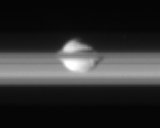Pan (moon)

Pan amid the rings of Saturn
|
|
| Discovery | |
|---|---|
| Discovered by | M. R. Showalter |
| Discovery date | July 16, 1990 |
| Designations | |
| Adjectives | Pan |
| Orbital characteristics | |
| 133584.0±0.1 km | |
| Eccentricity | 0.0000144±0.0000054 |
| 0.575050718 d (13.801217 h) | |
| Inclination | 0.0001°±0.0004° |
| Satellite of | Saturn |
| Physical characteristics | |
| Dimensions | 34.4 × 31.4 × 20.8 km |
|
Mean radius
|
14.1±1.3 km |
| Mass | (4.95±0.75)×1015 kg |
|
Mean density
|
0.42±0.15 g/cm³ |
| 0.0001–0.0018 m/s2 | |
| ≈ 0.006 km/s | |
| synchronous | |
| zero | |
| Albedo | 0.5 |
| Temperature | ≈ 78 K |
Pan (/ˈpæn/ PAN, Greek: Πάν) is the second-innermost moon of Saturn. It is a walnut-shaped small moon about 35 kilometres across and 23 km high that orbits within the Encke Gap in Saturn's A Ring. Pan is a ring shepherd and is responsible for keeping the Encke Gap free of ring particles.
It was discovered by Mark R. Showalter in 1990 from analysis of old Voyager 2 probe photos and received the provisional designation S/1981 S 13 because the discovery images dated back to 1981.
The existence of a moon in the Encke Gap was first predicted by Jeffrey N. Cuzzi and Jeffrey D. Scargle in 1985, based on wavy edges of the gap which indicated a gravitational disturbance. In 1986 Showalter et al. inferred its orbit and mass by modeling its gravitational wake. They arrived at a very precise prediction of 133,603 ± 10 km for the semi-major axis and a mass of 5–10×10−12 Saturn masses, and inferred that there was only a single moon within the Encke gap. The actual semi-major axis differs by 19 km and the actual mass is 8.6×10−12 of Saturn's.
The moon was later found within 1° of the predicted position. The search was undertaken by considering all Voyager 2 images and using a computer calculation to predict whether the moon would be visible under sufficiently favorable conditions in each one. Every qualifying Voyager 2 image with resolution better than ~50 km/pixel shows Pan clearly. In all, it appears in eleven Voyager 2 images.
The eccentricity of Pan's orbit causes its distance from Saturn to vary by ~4 km. Its inclination, which would cause it to move up and down, is not distinguishable from zero with present data. The Encke Gap, within which Pan orbits, is about 325 km wide.
...
Wikipedia
